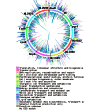NCBI Bookshelf. A service of the National Library of Medicine, National Institutes of Health.
Dean L, McEntyre J, editors. Coffee Break: Tutorials for NCBI Tools [Internet]. Bethesda (MD): National Center for Biotechnology Information (US); 1999-.
Getting by with the bare minimum seems to be the modus operandi of Mycobacterium leprae — the causal agent of leprosy. Its genome sequence reveals that it has undergone massive genome 'downsizing' over time, discarding more than half its genes and rendering it the most striking example of genome reduction in a microbial pathogen.
The leprosy bacillus is famed for being the first microorganism definitively shown to be associated with human disease. It evades the host's immune response by invading and propagating inside the vacuoles of macrophages called phagosomes. From there, it infects the Schwann cells of the peripheral nervous system, where it disrupts myelin production, thus leading to the characteristic features of leprosy, which include skin lesions and sensory loss.
Attempts to study M. leprae have been thwarted by fruitless efforts to grow it in the laboratory. This is due in part to its excruciatingly slow growth — it divides only once every two weeks, slower than any other bacterium — and its requirement for an elusive cocktail of nutrients. But the sequencing of its genome by Stewart Cole and colleagues now uncovers clues to its unique metabolism and unusual 'reductive evolution'.
M. leprae seems to have completely dispensed with or substantively reduced certain metabolic pathways, including oxidative and anaerobic respiratory chains. The enzymes for breaking down host-derived lipids, a means by which many mycobacterial pathogens derive their energy, are also drastically reduced in M. leprae. By contrast, most anabolic pathways seem to be intact, indicating that M. leprae depends on these pathways to survive in the nutrient-poor microenvironment of phagosomes.
Comparison of the genome sequence of M. leprae with that of its cousin Mycobacterium tuberculosis indicates that the former has undergone substantial downsizing, losing more than 2,000 genes since its divergence from a common mycobacterial ancestor. Presumably its genes became inactivated once their functions were no longer essential to survival, and this was followed by genome shrinkage through rearrangements and deletions.
The availability of the genome sequence will aid efforts to define virulence factors of the leprosy bacillus, of which few are presently known, and will provide inroads for developing new vaccines and diagnostic tests. Also, comparative genomic analyses with M. tuberculosis are likely to yield insight into the pathogenicity of the causal agent of tuberculosis and into potential drug targets based on the set of genes crucial to the survival of both organisms.
Story by Carina Dennis, Nature Reviews Genetics
Search TaxPlot for structures similar to E5
Created: April 30, 2001
Click on the link below to start an html tutorial.
Search for structures similar to E5
- Honey, I shrunk the genome - Coffee BreakHoney, I shrunk the genome - Coffee Break
Your browsing activity is empty.
Activity recording is turned off.
See more...

